Season Nine
Art Credit: Leila Wahab
We interviewed Dr. Catalina Cuellar-Gempeler, a professor of microbial ecology at Cal Poly Humboldt about her work on microbial community ecology on pitcher plants. This is Radiobio!

Art Credit: Leila Wahab
We interviewed Dr. Catalina Cuellar-Gempeler, a professor of microbial ecology at Cal Poly Humboldt about her work on microbial community ecology on pitcher plants. This is Radiobio!
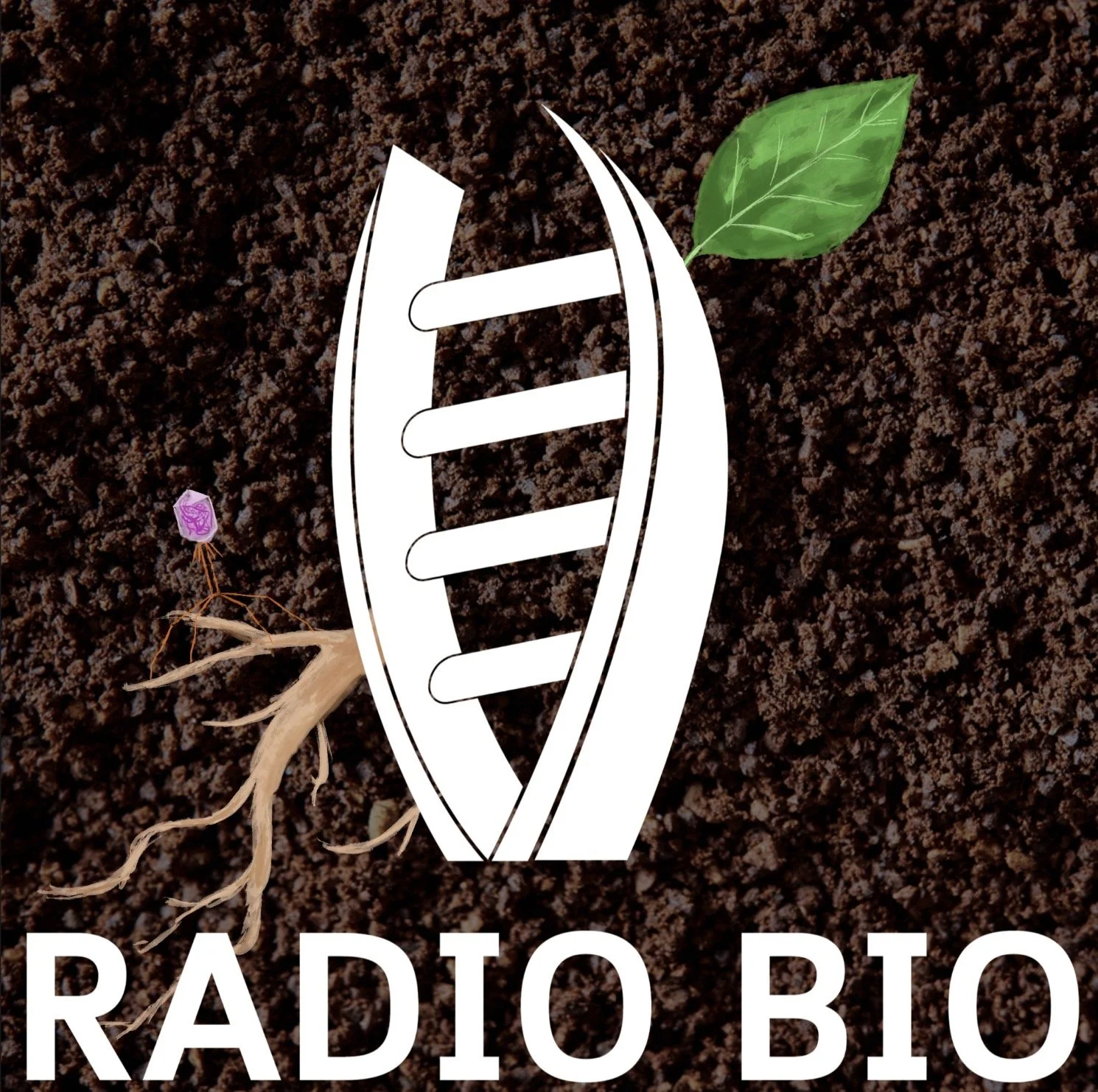
We sat down with Dr. Jonelle Basso, a research scientist at the Joint Genome Institute. She discussed how bacteria and viruses team up with their hosts to provide mutual benefits, and how her team uses genomic approaches to decode these underground partnerships. From computational analysis to experimental work, discover how scientists are unraveling the complex relationships between plants and their microbial allies. (This episode was recorded in Spring of 2024. Some information discussed may have changed since the recording date.)
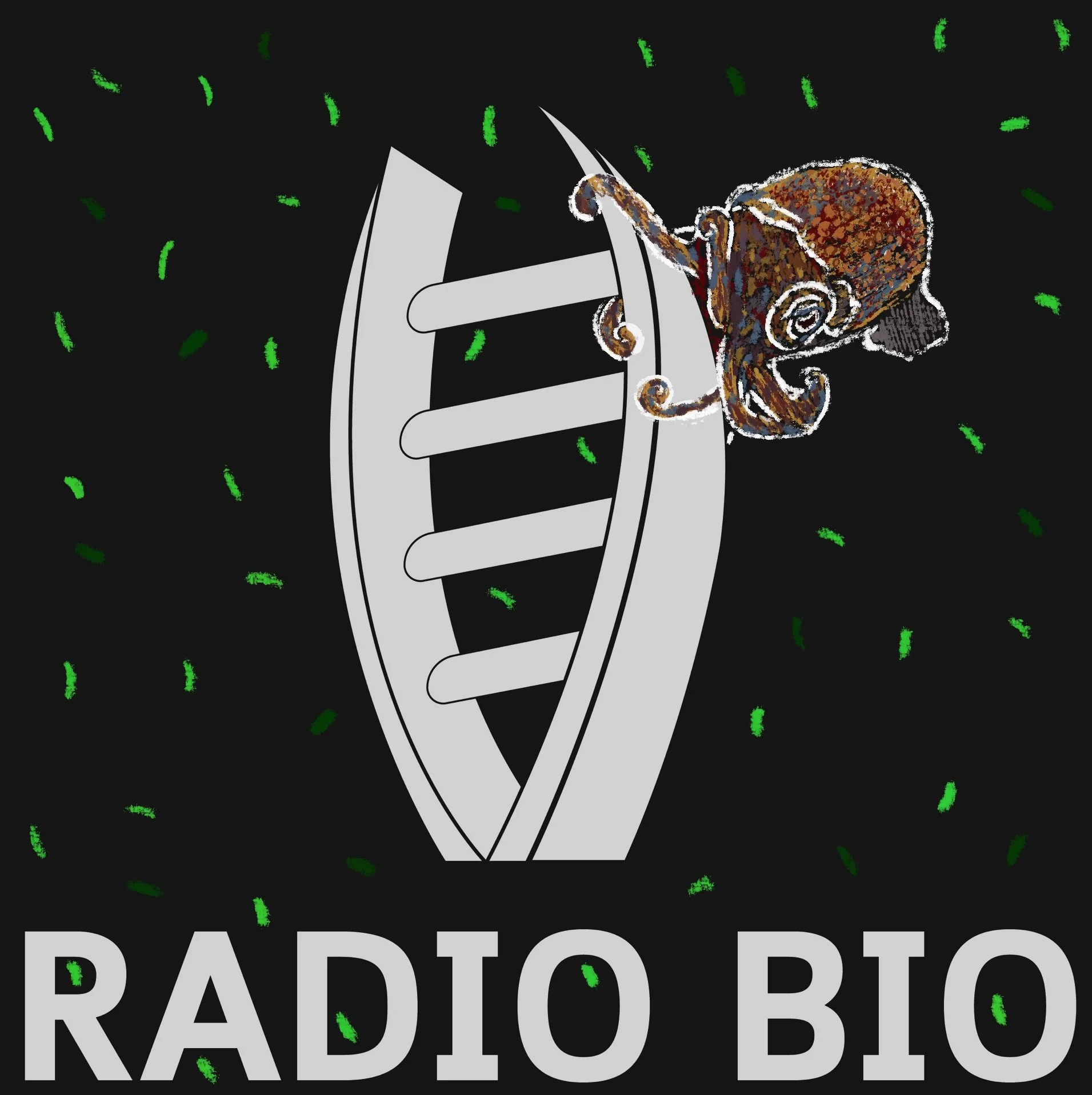
We chat with Dr. Spencer Nyholm about the symbiotic relationship between the Hawaiian Bobtail Squid and the bioluminescent bacteria Vibrio fischeri (now called Aliivibrio fischeri), and how they use bacteria to protect their eggs. (Recorded Fall 2022)

We talk with Dr. Emma Wilson about Toxoplasma, a microscopic parasite that makes mice love the smell of cat pee, can live in your brain forever, and might just make you more likely to take risks. (Recorded Fall 2022)

Art Credit: Leila Wahab
Nature versus nurture, the eternal question. We usually think of our genes as permanent, a part of our nature, something that is passed down to us and that’s it. But how much of our genes change as a results of our actions today? How much do our genes change because of what we have been eating for the past 10 years? Turns out, behaviors and the environment can actually change our gene expression! We delve into some of these factors with our fabulous guest this week, Dr. Monica Dus, a professor of neuroepigenetics at the University of Michigan. This is Radiobio!
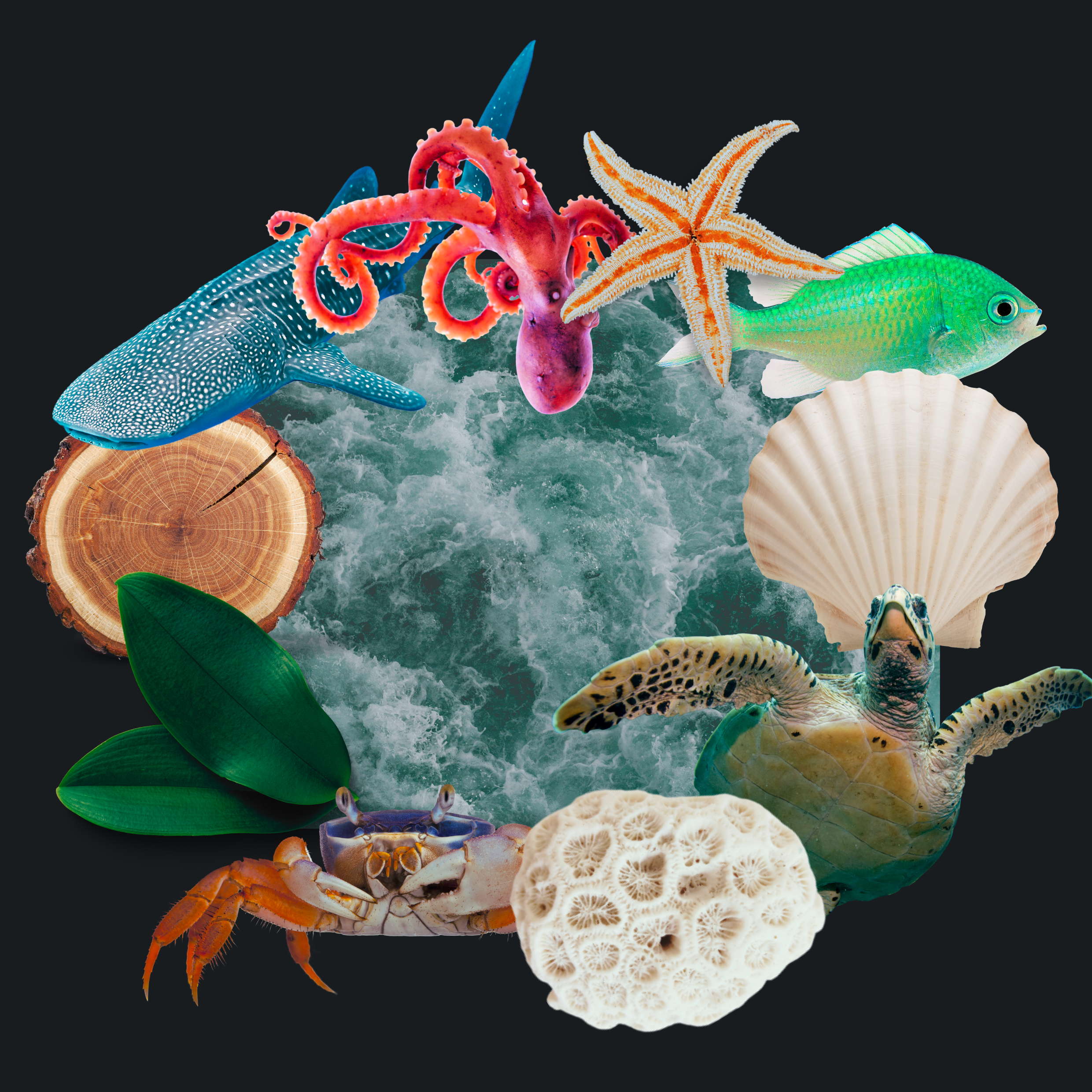
Art Credit: Maia Powell
There are plenty of fish in the sea… this week, we take that saying to a whole new level! Fish are incredibly diverse and their life cycle is complex; this week on Radiobio we talk with Dr. Chrissy Hernandez about her research on fish population dynamics. Dr. Hernandez applies math to complicated ecosystem level questions, with fascinating results. This is Radiobio!
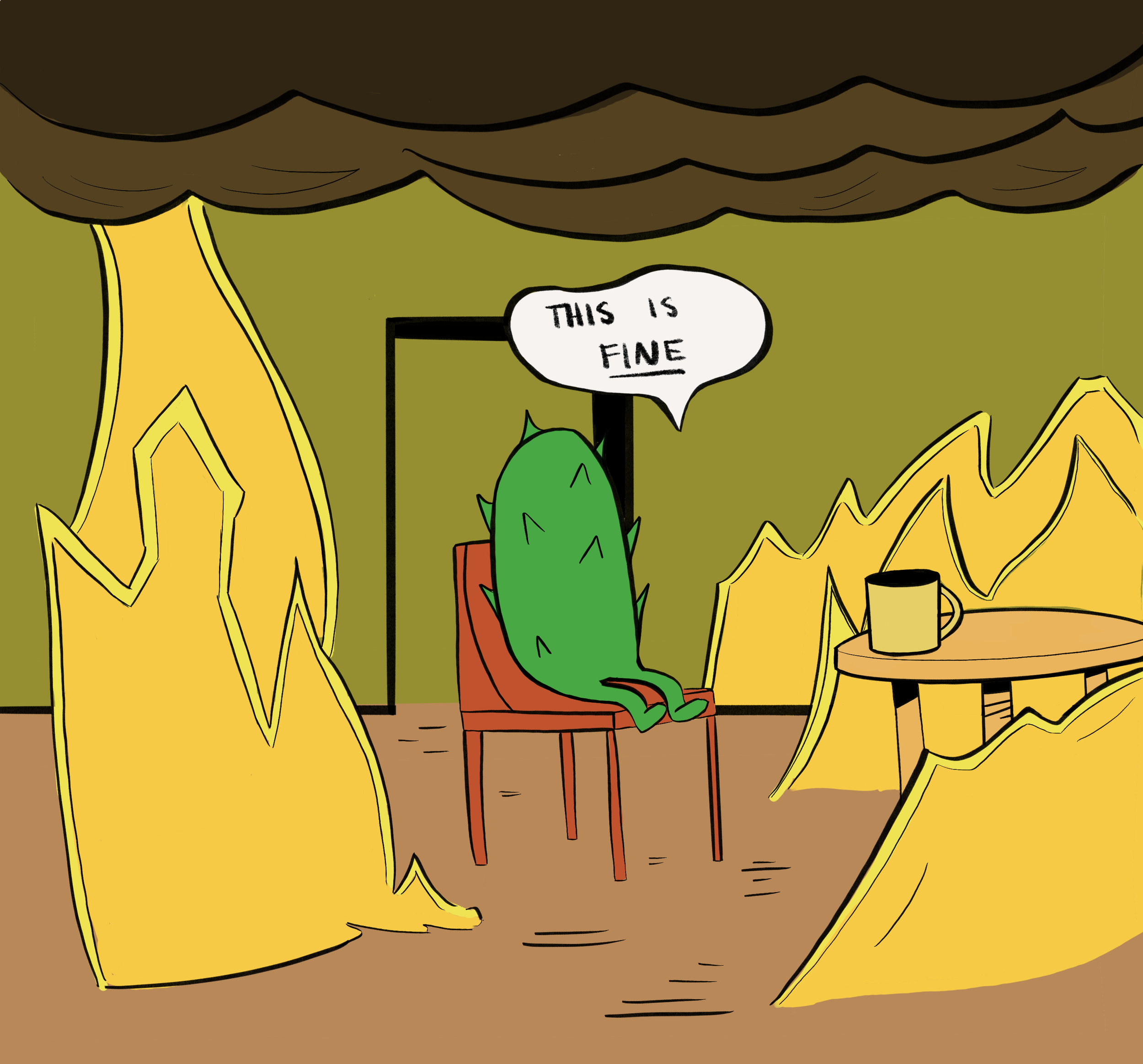
Art Credit: Leila Wahab
Imagine you are at a hot springs. The water is boiling and bubbling, there’s the smell of sulfur and other acrid chemicals in the air, and it is unbelievably hot. Is it possible that life can exist in these unforgiving conditions? It turns out yes! There are microbes, called thermophiles, that not only just exist in these conditions, but have adapted very particular ways of thriving in what are some of the most unforgiving conditions on our planet. This week, we talk to Dr. Ruben Michael Ceballos about these fascinating organisms.

Art Credit: Maia Powell

Art Credit: Leila Wahab
We’ve all heard of COVID-19, saw its impact on society, and probably even faced the respiratory illness itself. But is there… math behind this disease? And if so, can we use math to help fight COVID and other infectious diseases? It turns out that our collective behavior during outbreaks can mathematically fuel models of public health. Join us as we explore the fascinating world of mathematical biology. This is RadioBio.
The California academy of sciences is one of California’s oldest operating museums and research institutions. It is an invaluable repository of knowledge about the natural sciences, is home to 47 million specimens, and has hundreds of thousands of visitors per year. This week, on Radiobio, we had the privilege of speaking with Dr. Shannon Bennett, the chief and dean of sciences at the Academy. She gave us all the behind the scenes scoop about the academy of sciences, as well as her own fascinating path into science. This is Radiobio!

Art credit: Julia Alvarez
Imagine you're a squid, yeah okay its weird but just imagine it, you are a squid swimming at night. It's a dark night except for the light from the moon, and there is a predator roaming around looking for its dinner. Now imagine you are a squid who can camouflage yourself to match the light from the moon and the stars so your shadow disappears. You trick the predator while you go on your way looking for your own dinner. Seems kind of magical right? Well that's exactly what bobtail squids do, except they get help from their bacterial friends. Today on RadioBio we talk with Dr. Michelle Nishiguichi, a professor at the University of California, Merced about glowing squids and their symbiotic sidekicks.

Art Credit: Leila Wahab
Life finds a way. Even in the face of incredible pressure from other organisms, climate change, and pollution, species still find ways of persisting. Sometimes this pressure is too much, and populations go extinct. Why are some species able to survive, and others able to persist? How much pressure is too much pressure? And can species find ways to survive through their interactions with other species? We dive into all of these pressing questions and more with our guest this week, Dr. Diane Campbell, a distinguished professor from the University of California - Irvine

Art Credit: Maia Powell
We live in a microbial world. From our own gut to the corals in the ocean, microbes are key players in the existence of so many organisms. Did you know that corals are not just single organisms, but exist in symbiosis with millions of single celled algae? This symbiosis is currently threatened by global warming and climate change, resulting in a process you may be familiar with, called coral bleaching. This week, we spoke with Dr. Viriginia Weis about her timely and fascinating research on the topic of symbiosis between corals and algae.

Art credit: Julia Alvarez
Vaccines and drugs to mitigate sickness have become a central part of modern life, and they have become a central topic right now as the COVID 19 pandemic has progressed. But how are vaccines developed? What is the difference between a vaccine and therapeutic drugs? And could we actually one day treat coronavirus with a pill? Today, we talk to Dr. Robert Davey, a professor of microbiology from Boston University, who is currently working on ways to find treatments for dangerous viruses. This is chapter 1 of our COVID interview series, in which we interview a series of professionals on different topics related to the pandemic.

Art Credit: Leila Wahab
All over the news, we hear about drug development and vaccines, masks wearing, and being in a red or purple tier, but have you considered how this is affecting communities, maybe your community? In this interview with Dr. Kristina Allen, Deputy Director of Public Health from Mariposa county, we discussed coordinated response to the COVID-19 outbreak as well as the mental state of communities that have been affected by COVID-19, and how local governments and rural areas are fighting to keep their community alive. This is chapter 4 of our COVID interview series, in which we interview a series of professionals on different topics related to the pandemic.

Art Credit: Leila Wahab
This past year, we have been in the midst of a historical pandemic that has touched the lives of everyone around us. As part of our interview series on COVID-19, our team was interested in gaining the perspective of a medical doctor and how this pandemic has affected healthcare workers. For this episode, we interviewed Dr. Xavier Gaeta, a doctor currently in pediatric residency in a LA county, as well as a PhD. Dr. Gaeta gave us invaluable perspective on being a doctor during the pandemic and insight into the differential impacts of COVID on children versus adults. This is chapter 2 of our COVID interview series, in which we interview a series of professionals on different topics related to the pandemic.

Art Credit: Maia Powell
Throughout this historic pandemic, there have been many changes to our social and work environments that have been far from our baseline. Work from home, has led to greater isolation and less ability to socialize with our coworkers and friends. This has undoubtedly affected the mental health of people all over the world. This inspired us to reach out to a mental health professional, specifically Dr. Tania Gonzalez, our very own director for Counseling and Psychological Services (or CAPS) at UC Merced. This is our final chapter in this release series, and we hope you have enjoyed hearing from many perspectives to gain greater context for what we have all been experiencing this past year.

Art Credit: Julia Alvarez
COVID 19 has changed so many things about the world we live in, but few things have changed as much as our perceptions of public health and its role in our modern society. How has the US reacted to COVID 19, and what things could we have done better? What if our social services and health services could be better integrated? How does testing and contact tracing actually happen to monitor the transmission of coronavirus? Today, we answer all of these questions and more by talking with Dr. Zweifler, a medical consultant from the Fresno County Health Department. This is chapter 3 of our COVID interview series, in which we interview a series of professionals on different topics related to the pandemic.

Art Credit: Julia Alvarez
Imagine the world 430,000 years ago. What were our ancestors like? What if there was a population of people that no one ever knew about? Can we unravel the mystery of our history? Now imagine, your garden at home is full of aphids. Did you go buy some ladybugs at your local home depot? Have you ever thought where those ladybugs came from or what happens after they leave? Now these two situations may seem very different but they have one common theme. They both have questions that can be studied using population genomics. This week on RadioBio we talk about popgen, ancient humans, ladybugs and ghost populations (ooo spooky!) with Dr. Arun Sethuraman, an assistant professor at San Diego State University.

Art Credit: Maia Powell

Art Credit: Julia Alvarez

Art Credit: Maia Powell
Bats are vital for maintaining balance in the ecosystems they are a part of: Bats keep insect populations in check, pollinate flowers, and disperse seeds. Bats are also an incredibly diverse group of species that come in all shapes and sizes! Did you know, that if you randomly picked a mammal, you would have a one in five chance of picking a bat? Today we have Dr. Alexa Sadier with us to talk about what studying bats can teach us about evolution.

Art by Reina Warnert
Ants, they are everywhere if you look for them! Ants engage in all the things that we associate with our own society, like farming and policing, and have complex social structures. This week on Radiobio, we talk to Dr. Ehab Abouheif, a professor from McGill University, about his research on cooperation in ants and the microbes that exist in symbiosis with them.
link to nature paper: doi.org/10.1038/s41586-020-2653-6
link to deborah gordon: User-386034408 – Radiobio-interviews-dr-deborah-gordon
What if I were to tell you that you had hundreds, if not thousands of microbes living on you hands, you would probably respond with ewwwwww...gross and immediately want to sanitize or wash our hands. If I were to tell you that not all of them are bad, but rather most of them are good, you might still be skeptical. Let’s take it one step further. What if I told you that we can use naturally occurring bacteria as a form of pest control. Wild right! One of these bacteria is Wolbachia. Wolbachia affects the reproductive system in certain insects and can make them sterile. The cool part is that Wolbachia do not affect humans or other large invertebrates, but it does infect many insects that we classify as pests. Today we explore the world of Wolbachia and learn about how these little bacteria can kick some insect pest butt with Dr. Amelia Lindsay......This is RadioBio!

Art by Leila Wahab
Have you ever thought about the soil beneath your feet? Let's take it one step further... have you ever thought about everything that lives in the soil beneath your feet? Well, prepare yourself, because this week we interview Dr. Lauren Hale, a researcher from the US Department of Agriculture, the USDA, about her research on the soil microbiome. Dr. Hale talks about soil health, nutrient cycling, and the cutting edge of research on the microbial world living underneath our feet
This week on RadioBio, we explore insect wings. Did you know insect wings are more than just beautiful appendages? They are a part of an amazing circulatory network. We discuss the biomechanics of insect wings and what makes them so amazing with Dr. Mary Salcedo, a postdoc at Virginia Tech.
Link to Dr. Salcedo's Review: https://doi.org/10.1093/icb/icaa124
Link to Dr. Salcedo's Website: https://www.maryksalcedo.com

Art by Shari Larsen
We are still discovering the mysteries of the brain and one way to do that is to use tools such as computers. On this episodes of RadioBio, we speak with Dr. Kanaka Rajan, a computational neuroscientist at the Icahn School of Medicine at Mount Sinai.

Art Credit: Anh Diep

Art Credit: Leila Wahab

Art Credit: Maia Powell
The immune system is complex, full of lairs of communication and strict regulation, all to keep us healthy and alive. But what happens when those checkpoints break down? In this weeks episode, we learn about how B-cells can turn against us and what that means. We talk to Dr. Roberta Polenda from University Colorado, Denver about her research on this subject.
From gummy bears to cars we learn the importance of adhesion and lubricants for everyday life. Whether you're a muscle on a rock trying to hold on during high tide, or you're a runner and relying on the lubricants to keep your knees moving. The research that is conducted to understand these phenomenon can help us fix issues in health care that many of us suffer from, such as arthritis or joint damage from injuries. Today, we will explore the concepts of adhesion and lubricants that are all around us with this weeks guest Dr. R. A. Eguiluz.
Ever wonder what it takes for a forest to regenerate after a devastating wildfire? Turns out microscopic fungi in soils play a big role in that recovery. These fungi partner up with all kinds of plants, helping out in many environments and industries, from helping crops to flourish to restoring plant biodiversity. Join us as we discuss these topics and more with Dr. Sydney Glassman.

Art by: Julia Alvarez

Art by: Jasper Toscani Field

Art by: Anh Diep
Spring and Fall are often accompanied by a chorus of sneezes-- allergies are the bane of this beautiful time! Allergies, our immune system’s response to foreign substances, can be more than uncomfortable-- long term exposure to allergens can be linked to chronic pain. This week on RadioBio We talk with Dr. Devavani Chatterjea from McAlaster College about her work investigating the link between allergies and chronic pain.
DNA is all over the place. It sheds from everything, everywhere, throughout time. What if you could just scoop it up and figure out what it is... well, we can! Environmental DNA, or eDNA, is DNA that's left over in the environment and is an important tool we can use to understand life as we know it. This week on RadioBio, we talk with Dr. Rachel Meyer from UC Santa Cruz all about eDNA-- how you collect it and what you can do with it, and even how you can get involved. This is RadioBio.
Achoo! Ah, allergies, the first sign of spring or also a sign that the barista accidentally did make your coffee with whole milk instead of soy. But what is your body doing during an immune response? Particularly, an allergy immune response. And why are your cells causing you so much misery? Well, join us this week as we dive into the fascinating roles that our immune system plays during allergic responses with Dr. Richard Locksley.

Art by: Laura Van Vranken

Art by: Julia Alvarez

Art by: Leila Wahab
Humans might be the worlds greatest evolutionary force. From pollution to deforestation, human induced changes have a huge impact on the environment around us. But how are animals adapting to the changes in their environment? This week on RadioBio, we talk with Dr. Rachel Bay from the University of California, Davis about her work investigating evolutionary genomics in an ever-changing world.
Have you ever wondered why pregnant women shouldn't change the litter box? How about why your meat should always be well cooked? Well, one of those reasons is Toxoplasma gondii. Over 2 billion people are infected with this brain parasite. However, our understanding of the effects of Toxoplasma on humans, especially on their brain are small. Almost as small as the parasite itself. This week on RadioBio, we discuss who gets this parasite, what we can do to prevent or treat it and an introduction into the research taking place to discover the role of this parasite in the body with Dr. Rema McLeod from the University of Chicago. This is RadioBio.
Have you ever wondered what's the difference between a bug and an insect? Are spiders even an insect? Wait are lobsters and crabs related to bugs? Why do we even care about these insects and parasites? Well, we all know that bees are important for our food because they pollinate many of our plants that produce food for us, but insects have lead to many other discoveries. Did you know that many human genes that have been shaped by Darwinian evolution are genes that are involved with dealing with viruses and large parasites? Crazy right? Well today, we dive into Dr. Whiteman's work that follows Darwin and Wallace discoveries which is focused on evolution of new traits that are shaped though interactions between organisms. This is Radio Bio!

Art By: Leila Wahab
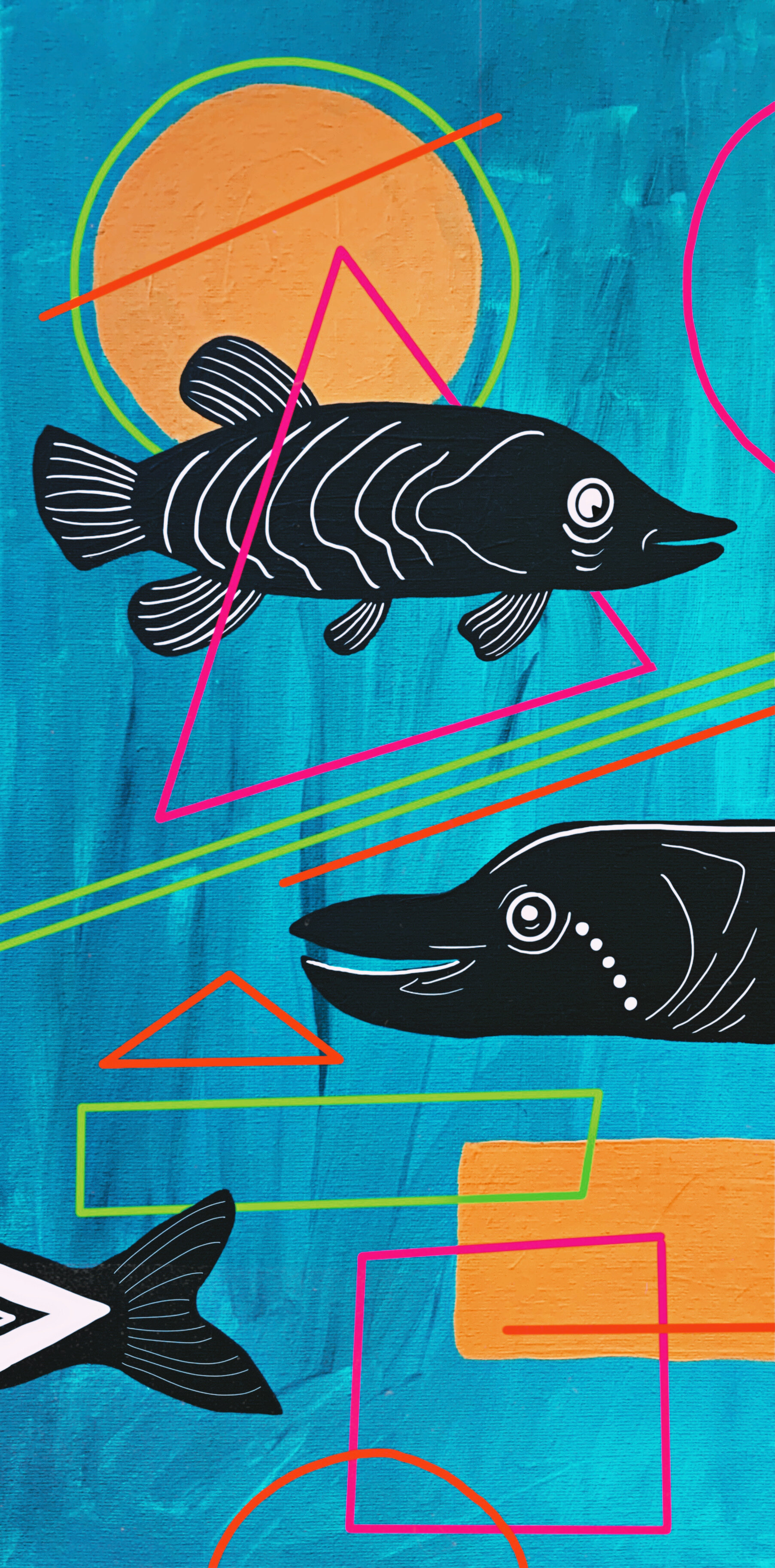
Art By: Maia Powell
It can be hard to make decisions, but do you know that your cells makes decisions too? What is even more amazing is that we can actually watch cells do this. This week we discuss cells and how they communicate and understand each other with Dr. Orion Weiner from the UCSF Cardiovascular Research Institute.
Life is complicated. Breaking down the living world into understandable pieces requires good experiments AND good theories. Science thrives on the feedback between theory and data. Our guest today specializes in connecting theories and models to empirical data from experiments. Join us for a fascinating discussion of ecological models, ecological experiments, and everything in between!

Art credit: Kinsey Brock
Have you ever thought about brains? Our brains are seriously important, that's not news, but how do they actually work? There is a delicate balance between order and chaos. RadioBio this week is all about stability in the brain. Hopefully by the end you'll know a little bit more about how your brain works!

Art credit: Anh Diep
CRISPR. You may have heard about it in the news. It's arguably the biggest discovery of the 21st century, and could possibly be a cure for some of the genetic disorders that have plagued humans throughout our history. It was initially identified in the early 1990s and more recently it was discovered to be the immune system used by bacteria to fight off viral infections. Until recently there were no known mechanism for inhibiting the infections caused by these bacteria-infecting viruses. Dr. Joe Bondy-Denomy is a leader in the CRISPR field and discovered anti-CRISPRS, the system used by viruses to hide out from the bacterial CRISPR system. We talk with him about his discoveries in the field and the ethics of gene editing in humans.

Art credit: Anh Diep
Have you ever been curious about how our brains "learn" and why only somethings seem to "stick" and others seem to fade away as time goes on? I know I have. How are memories stored? Today we are going to explore the brain's amazing ability to learn and store information over a lifetime, as well as a recently discovered mechanism of neuronal communication that resembles the life-cycle of retroviruses.
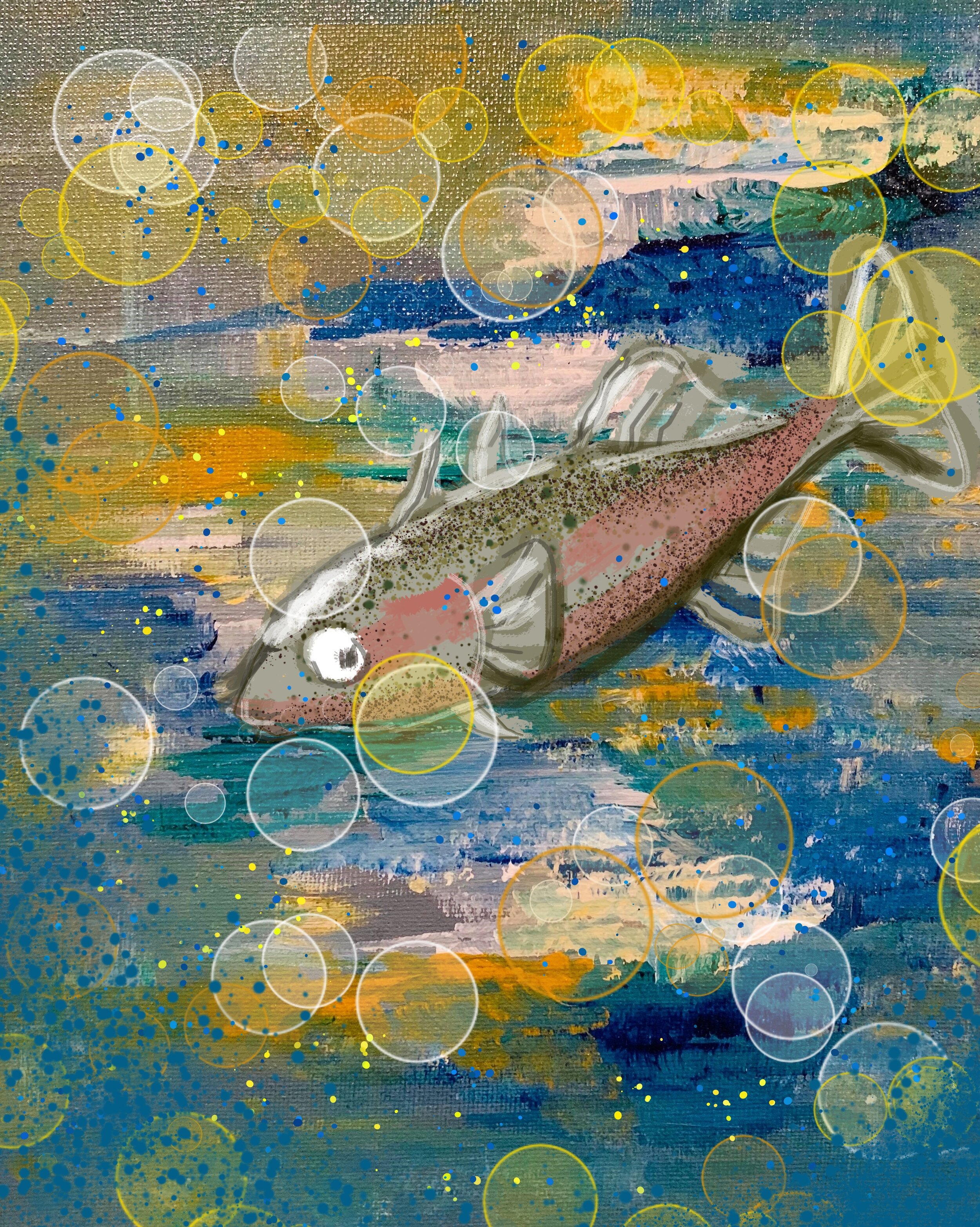
Art credit: Anh Diep
You and I .... are completely different.... Not just because we like different music or have different parents, but because we are more than individuals. We contains multitudes of microbial communities and, believe it or not, my community is different than yours. Today, we are talking with Dr. Kathryn Milligan-Mhyre about her research into how microbes associate with hosts and how those microbes change over time.

Art credit: Jackie Shay
Do you grow your own food or butcher your own meat? Many of us don't. We get our food from a lot of different places in our modern society and we have a global network of food import and export. But what happens when there is contamination in our food supply? How do we know where the contamination is coming from when our food is coming from all over the place? Join us as we find out how we can use genomic data to explore this issue in this episode of RadioBio.

Art credit: Anh Diep
Have you ever thought about how weird hybrids actually are? Some hybrids seem to be a contradiction: they can't reproduce! How could nature allow this? Today we discuss the evolutionary conflict of speciation, hybrids, and sterility.

Art credit: Kinsey Brock
Have you ever thought about how light affects your behavior on a day to day basis? Now think about how light would affect you on a molecular scale? Molecules have a direct influence on behavior from sleep cycles to depression and motivation. Today we discuss molecules, how they affect animal behavior, and the origins of such an intimate relationship in molecular biology.

Art credit: Jackie Shay
It's getting warmer and drier, but there may be an untapped natural resource that can offer fresh water: fog! Fog is more than just one way your beach day can be ruined-- Coastal fog has the potential to be a major contributor to future sustainable agricultural practices. Today we discuss fog and its impact on crops in California.

Art credit: Julia Alvarez
This week is a special edition of RadioBio, put on for UC Merced's International Education Week. In this episode, we hear from five different researchers and their unique experiences with international research: Dr. Asmeret Asefaw Berhe, Dr. Felipe Zapata, Dr. Gregory Mutumi, Dr. Samuel Wasser, and Dr. Teamrat Ghezzehei. From soil science to conservation biology to everything in between! Each story highlights the various ways we can be inspired by the world around us, and how science reaches beyond physical and political boundaries. Join us, as listening to life, goes international!

Art credit: Kinsey Brock
What is a virus? Why are they important? Viruses can cause disease and mortality, and they also significantly influence ecosystem ecology and environmental chemistry. Today we discuss viruses and their role in biogeochemical cycles and agricultural systems with Dr. Joanne Emerson from UC Davis.

Art credit: Kinsey Brock
Here's a riddle for you, what is something that stays behind in an environment after an animal is long gone? The answer is... POOP! What if we could use poop to study animals that would otherwise be difficult to track down? Well, Dr. Sam Wasser does just that. This week on Radiobio, we talk with Dr. Wasser from the University of Washington about how he uses poop to better understand animal populations with implications from tracking poachers to tracking whales.

Art credit: Jackie Shay
Matter in a random universe. How does it behave? Can we predict it? When physics meets biology, this intersection between two disciplines can crack some major gaps in our understanding of how matter transforms from one state to another. Today we discuss proteins that change their physical state and the theory that goes into understanding this state change.

Art credit: Jeff Lauder and Kinsey Brock
Water. It is one of the basic requirements of life as we know it, especially in California. The Washoe people of California's Sierra Nevada mountains believe that all water bodies contain water spirits known as water babies that dictate if you will catch fish or if the river will run dry. And these beliefs are founded in the reality of water's significance...the Sierra Nevada mountains are the reservoir of California, with more than 60% of the state's water originating in the mountains. Our history, our economy, our entire being is tied to how much water falls on these mountains. But what happens...when the water stops?
Today, Kinsey Brock, Morgan Quail, and I, Jeff Lauder, speak with a hydrologist and three ecologists about what made the 2012-2016 drought so historic, and how studying its impacts on forest ecosystems can help us understand what a changing climate means for California.

Art credit: Kinsey Brock
Rolling grasslands at the edge of the UC Merced campus and the foothills of the Sierra are bright green with temporary pools in the spring and a dry golden yellow in the fall. Believe it or not, this dynamic ecosystem is home to a diversity of unique flora and fauna. RadioBio interviews four scientists who each study a different part of one of California’s most surprising ecosystems: vernal pools!
Featuring:
Vernal Pools Reserve Director, Monique Kolster
Ecohydrologist, Dr. Mark Rains
Herpetologist and Conservation Biologist, Dr. Brad Shaffer
Biologist, Shannon Kieran
Thanks to Belinda Braunstein for the coyote audio from the UC Merced reserve.

Art credit: Kinsey Brock
Infections occur when foreign invaders take root in the human body. When most people think of infections, they think of bacteria and viruses. These however, are not the only invaders our body has to watch out for - fungi are also able to cause disease in humans. You all may be familiar with mild fungal infections, such as athletes foot and yeast infections. Some fungi however can cause life threatening illnesses. One fungus, Histoplasma capsulatum, is capable of causing severe respiratory infections. Dr. Anita Sil from UCSF chat about how this fungus gets into our body and how we clear it. Sponsored by UC Merced SACNAS.
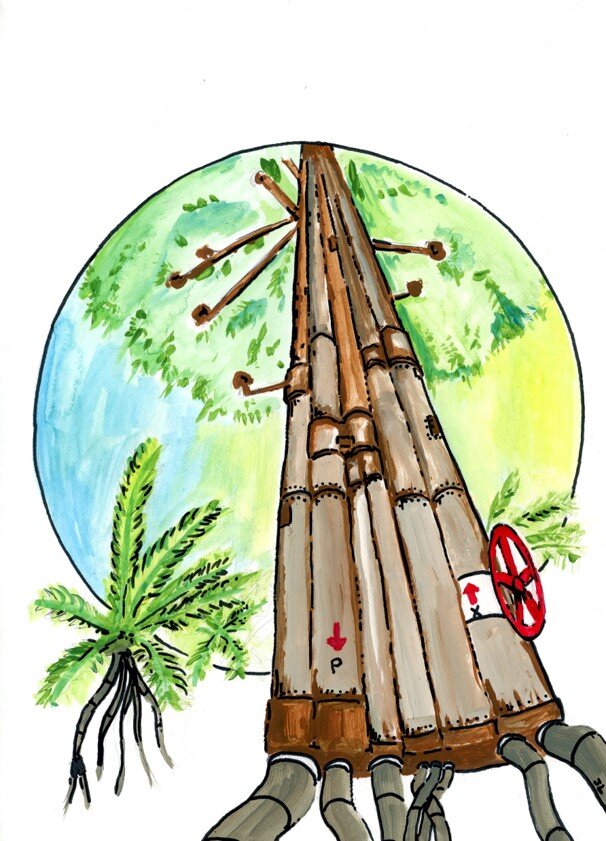
Art credit: Jeff Lauder
Extreme drought is one of many impacts of climate change. Globally, we have seen droughts increase in duration and intensity, with many negative impacts on natural ecosystems, crops, and our economy.
This begs the question - how do plants deal with drought?
Our guest today, Dr. Jarmila Pittermann, studies plant ecophysiology — how plants are structured and what that structure means for how plants respond to their environment. She seeks to understand how different plants use different strategies for surviving drought by zooming in to look at their internal workings, their plumbing. Her exploration of the various systems plants have developed for moving and using water is showing us that some plants use some pretty unique methods for dealing with drought.

Art credit: Jackie Shay
Do you ever stop and smell the flowers? Do you feel like you only like certain kinds? Well, a bee would agree. Did you know scents are different because of species interactions? In a field of flowers, there are a lot of complex interactions at play that allow those flowers to coexist. But how does it all work? Today on RadioBio we talk with Dr. Sharon Strauss about the complexity behind species coexistence.

Art credit: Jeff Lauder
When you think of ways to slow down climate change, what pops into your mind? Reduce, reuse, recycle!! Perhaps to never use fossil fuels again? These are things that we, as humans, can actively do to decrease our impact on earth's climate. We're not alone in the fight against climate change tho-- plants play an important role just by being, well, plants. This week on RadioBio, Dr. Silver from UC Berkeley tells us about how plants, together with soil microorganisms, help capture carbon from the atmosphere and store it in the ground; and what we can do to help.

Art credit: Kinsey Brock
Red on yellow, kill a fellow. Red on black, friend of Jack. Some species use bright colors in different combinations to tell potential predators to back off, bub. Eat me and you'll be sorry. But not always.... Throughout the animal kingdom, species have evolved ways of faking out their enemies. Dr. Alison Davis Rabosky tells us about natures con artists, the mimics, and how these crafty creatures can actually drive evolution in their poisonous counterparts

Art credit: Kinsey Brock
We are all probably familiar with antibiotics, we have probably even taken them.
Resistance to antibiotics have been in the news recently. But what is it? How does antibiotics resistance develop and are there ways to combat it? Dr. Tricia Van Laar chats with us and shares insights on antibiotic resistance.What if you could prevent something bad from happening? When it comes to epilepsy, you never know when a seizure could happen next. The ability to predict an incoming seizure can be a game changer. Today we have the pleasure of chatting with Dr. Jeanne Paz about her incredible work aimed at seizure prediction and prevention

Art credit: Kinsey Brock
What if you could prevent something bad from happening? When it comes to epilepsy, you never know when a seizure could happen next. The ability to predict an incoming seizure can be a game changer. Today we have the pleasure of chatting with Dr. Jeanne Paz about her incredible work aimed at seizure prediction and prevention

Art credit: Jeff Lauder and Morgan Quail
We often imagine a cell as a large balloon filled with jelly, but really it is more like a large city. Packages need to go from one place to the other in an organized fashion as to not disrupt other processes. For example, when we need an item, we go to the store or click away on retail websites, but how do these items find their way to the retail place or our house? There are vehicles on roads and highways that are utilized for distribution. Much like the infrastructure that we use everyday to move cargo around our cities, the cell has its own system to deliver goods from one place to another. What are the 18 wheelers of the cell, how do they move such important packages, and how do they know where to go? Cytoplasmic dynein is a protein complex that transports molecular cargo along and plays a key role in the intracellular trafficking network. Dr. Danielle Grotjahn utilizes specialized imaging techniques to study these structures and the function of motor proteins.

Art credit: Anh Diep
Symbioses, the interactions between two different species, make the world go ‘round. Everything from our agricultural systems to our own gut depends on groups of interacting organisms doing their thing. Our guest today, Dr. Alison Hansen, studies how a common aphid gets its nutrition. It turns out that its entire diet is dependent on a bacterium living inside each and every aphid. But how did it get there? What does it do for the aphid? Let’s dive into the big world inside small insects.

Art credit: Jackie Shay
Do you think you can put a number on the amount of species you've seen in your life? Absolutely not. Just stepping out onto the city street, there are countless species around us at all times. It's a huge amount of biodiversity. But what does that even mean and how do we study it? This week on RadioBio, we are joined by Dr. Felipe Zapata from University of California Los Angeles to discuss just that.

Art credit: Kinsey Brock
A lot of people don't like bats, even Batman is afraid of them. But maybe people are just afraid of what they don't know. Today Dr. Greg Mutumi talks to us about what makes bats so unusual, interesting, and, like he said earlier...cute!

Art credit: Anh Diep
When you are thinking about how the world works, how often do you think about the tiny forces of nature? Just about never, what do you mean? I mean microbes! They play an important role in ecosystem processes such as decomposition and nutrient cycling. But what do we know how these microbes live in nature? It turns out they live in communities, just like we humans do. In this episode we talk with Dr. Jennifer Martiny from UC Irvine about her work with microbial communities.

Art credit: Kinsey Brock
"The thymus is a really ugly-looking organ, but tastes fantastic. Have you ever had sweet breads?" In case you don't know, sweetbread is the culinary term for the thymus, but what is the thymus, besides a tasty dish? In this episode Genevieve and Stephen sit down with Dr. Jarrod Dudakov and discuss what the thymus is, its function, and why it is worth researching.

Art credit: Kinsey Brock
Have you ever wondered what powers us? We all consume food for energy, but HOW does that actually turn into energy? You may be familiar with the molecule ATP, or adenosine triphosphate. ATP is used to store energy from the breakdown of food, and through a process called hydrolysis, that energy can be released and transferred to power reactions. This tiny but mighty molecule is what powers nearly every reaction in our cells. In this episode, we journey inside the cell as we learn more about this powerful molecule, and the specialized structure inside the cell where its made, the mitochondria.

Art credit: Kinsey Brock
Imagine a world with no leaders. No Presidents. No generals. No bosses. No central control. Ants have successfully occupied every continent on earth and even though they have a queen, they use a system with no central control which we term collective behavior. But what is collective behavior? How do we begin to understand behaviors that emerge in a spontaneous way? Dr. Deborah Gordon, Professor of biology at Stanford University, joined us to talk all about collective behavior in ants.

Art credit: Jeff Lauder
How do you search for a virus? Even worst, how do you search for a virus's DNA? A virus you've never seen before and have no clue what it looks like! If you think of one of your cells as the size of a baseball stadium, a virus would about the size of a baseball. You could try a targeted approach by sequencing your best, educated guesses but with metagenomics you can sequence everything but the kitchen sink. This week we talk small viruses and big data with Dr. Eric Delwart.

Art credit: Kinsey Brock
Evolution; no small topic. Biologists can use a diverse array of systems to try to test evolutionary concepts. Some systems, like bacteria, are useful for looking at how evolution happens in real time, because they have such short generation times. Others, like animals, are much more difficult, but can allow us to ask really interesting questions like how behavior influences evolutionary processes. Dr. Kathleen Ferris asks questions about how organisms respond to stress in an evolutionary sense using two very different systems.

Art credit: Kinsey Brock
How do misfolded proteins cause human neurodegenerative diseases, like Alzheimer's, ALS, and Parkinson's? The Gitler lab at Stanford University studies the cellular biology underlying protein-misfolding diseases using the model organism yeast. Since dealing with misfolded proteins is an evolutionary problem, they hypothesize that the mechanisms employed to cope with misfoldings is likely conserved from yeast to humans. Gitler's long-term goal is to identify the critical genes and cellular pathways affected by misfolded human disease proteins.

Art credit: Jackie Shay
Everyone knows what hunger feels like and understands the drive to seek food when hungry, but how does it work? Dr. Zachary Knight from UCSF joins RadioBio to discuss his work on understanding the pathways in the brain that sense hunger to drive behavior. Knight's work is revealing new insights into how the brain makes decisions about food, whether it looks tasty, and how hunger dictates behavior. These results could lead to important advances in our understanding of eating disorders.

Art credit: Kinsey Brock
Have you ever wondered why males and females of a species are different sizes, shapes, and colors? Dr. Marie-Claire Chelini, University of California Presidential Post-doctoral Fellow, discusses her research on the evolution of sexual size dimorphism in crab spiders.

Art credit: Jackie Shay
You may have heard about the human microbiome or even the pro-biotic fad, but how much do you really know about the micro-organisms that live on and in you? Dr. Embriette Hyde from UC San Diego discusses her work with the American Gut Project on understanding the world of human microbiome. This work could lead to advances in our understanding of both the human health and human disease.

Art credit: Jeff Lauder
How do cells interact with their physical environment? Dr. Otger Campas from the University of California, Santa Barbara joins RadioBio to discuss the physical properties of cells and how the interactions between cells and their environment shape cell and organism development.

Art credit: Jeff Lauder
N at work. What is N? N, or nitrogen, is one of the most abundant gases in the atmosphere and is an elemental building block of life. But we can't use N from the atmosphere, we need help nitrogen fixing bacteria and plants to acquire N in a form we can use. Dr. John Stark from Utah State explains N, how it flows through natural ecosystems, and the organisms that make it work!

Art credit: Jackie Shay
If you've ever had a pet or known someone with a pet, you probably know what a round worm is, but did you know these are nematodes? 180 years of visualizing these fascinating worms gives us insight into biodiversity, evolution, and marine ecosystems. This week Dr. Holly Bik from the University of California, Riverside guides us through an exploration of these mysterious deep sea creatures using both ancient and novel techniques.

Art credit: Kinsey Brock
Have you or someone you know been affected by sleep disorders, depression, or even drug or alcohol addiction. Believe it or not this may be linked to how and when you sleep...which is actually controlled by when you eat.
Dr. Joanna Chiu, Professor of Entomology at UC Davis, studies the animal circadian clock and its control on organismal physiology. Besides being indispensable for the control of daily activities, defects in circadian rhythms and clock genes have also been implicated in a wide range of human disorders. The Chiu lab's goal is to dissect the molecular network and cellular mechanisms that control the circadian oscillator in animals, and investigate how this clock interacts with the environment and metabolism to drive rhythms of physiology and behavior.

Art credit: Kinsey Brock
We may not think about it this way, but there is a whole world of colors that we can not perceive or understand that other organisms use on a daily basis, like butterflies. Did you know that even males and females from the same species see the world differently? Today on RadioBio, Dr. Adriana Briscoe discusses the evolution of color vision in Heliconius butterflies using genes, physiology, and behavior.

Art credit: Jackie Shay
Viruses are iconically challenging to define, but they have DNA so they evolve. In the 1980s, the Human Immunodeficiency Virus (HIV) shook the world and propelled a massive undertaking to study the evolution of drug resistance in viruses. On World AIDS Day, December 1st, 2017, we spoke with Dr. Pleuni Pennings from San Francisco State University about how viruses adapt to treatments through time.

Art credit: Kinsey Brock
Two words: Flying Lizards. How'd it happen? Evolution. Evolutionary history is complicated. It can sometimes be helpful to look at funky animals to see what their unusual traits tell us about their history. For example, Dr. Jim McGuire from the University of California Berkley, studies the evolutionary correlates of size, color, and flight in lizards.

Art credit: Kinsey Brock
Dr. Heinrich Jasper shows us new tools using Stem Cells that can help with both our longevity as well as degenerative disease. The Jasper lab is focused on regulatory mechanisms that control stress tolerance, metabolism and aging with the help of fruit flies. In particular, Dr. Jasper has been recognized for making seminal discoveries about the effects of aging on stem cell behavior, and about the role of stress in regulating stem cell function. Current projects in his lab focus on the control of tissue regeneration, metabolic homeostasis, and cell death by insulin and stress signaling pathways. Here we learn how science moves from a bench in a lab at a school into an industrial clinical setting.

Art credit: Kinsey Brock
Everyone gets sick, but have you ever thought about how your body fights off infections? Dr. Ellen Rothenberg from CalTech studies the development of a white blood cell that plays a big part in keeping you safe from infections, the T cell. She takes us on the harrowing journey that a T cell takes in order to become the powerful protector that it is.

Art credit: Jeff Lauder
Genetics is a majorly hot topic in biology right now -- everything is genome sequencing this, gene expression that -- but how much do we really know? We know a lot about which genes are present in which organisms, and what certain genes do, but not a lot about how or why they do it. Our guest today, Dr. Rob Philips, is a researcher at CalTech who is working to understand the language of gene regulation, and the methods we can use to understand how genes work.
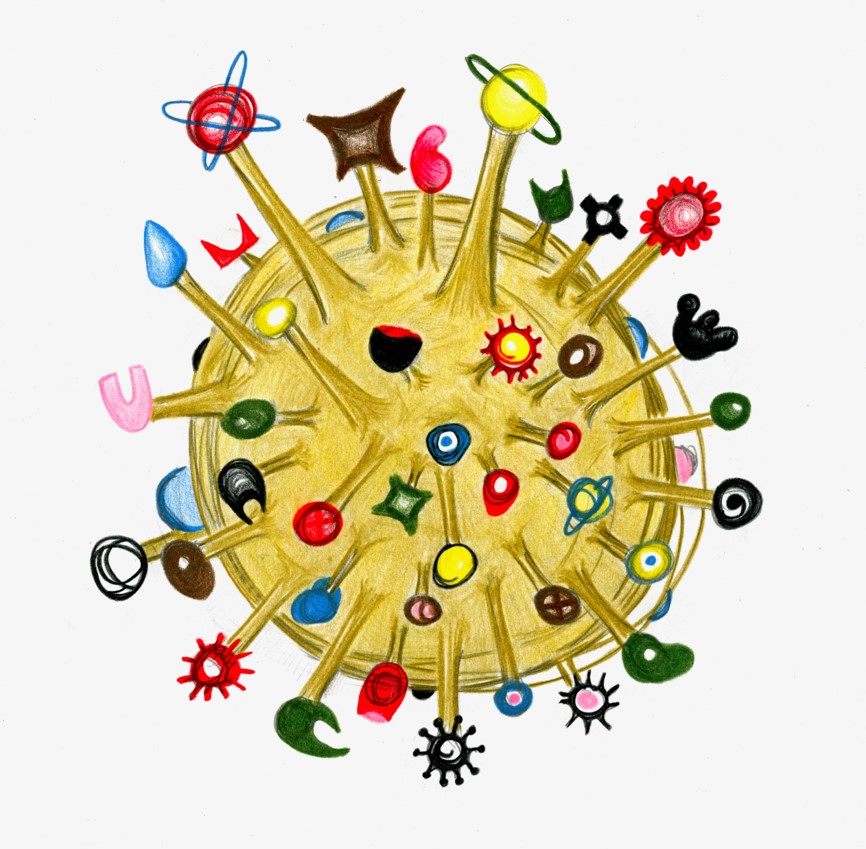
Art credit: Kinsey Brock
Autoimmune diseases occur when our immune systems start to attack our own cells, rather than foreign invaders. Unfortunately, very little is known about how these disorders arise in otherwise healthy individuals. Join us as we talk with B-cell immunologist and autoimmune clinician, Dr. Julie Zikherman, as we discuss how to control these inappropriate immune responses.

Art credit: Jeff Lauder
Everyone knows the mitochondria is the powerhouse of the cell. But what changes does it undergo to promote cancer and other diseases? We sit down with Dr. Nathan Lanning of California State University, Los Angeles and discuss his work regarding mitochondria dysfunction.

Art credit: Kinsey Brock
The famous geneticist Theodosius Dobzhansky once said, "Nothing in biology makes sense except in the light of evolution." But how do we study evolution? How do we reconstruct evolutionary relationships amongst hundreds, even thousands of taxa across the tree of life? Can we really predict how fast species evolve? Dr. Emily Jane McTavish, Assistant Professor in the Quantitative & Systems Biology graduate group at the University of California, Merced, joins us to talk about her research as a phylogeneticist and computational biologist.

Art credit: Jeff Lauder
What are coelacanths? Why would a marine fish contain chitin, a sugar that makes up the exoskeleton of insects? How do sharks sense fish? Why do we care about lamprey immune systems? Dr. Chris Amemiya from the Benaroya Research Institute studies these questions using comparative genomics. This research will improve our understanding of marine ecology as well as immunology, and holds implications for both the medical and biotechnical fields.

Art credit: Kinsey Brock
In many cells, RNA plays an essential role in regulation. Technological innovations are needed to further understand the role of RNA molecules in regulating basic biological function. Further, there is a need to expand the biochemistry toolkit to understand how large groups of RNAs are working in parallel inside living cells. The Spitale lab develops novel biochemical approaches toward understanding the role of RNA molecules in normal cell biology, as well as disease. Today we are going to learn about these new methods and tools in the RNA world from our guest Dr. Spitale himself.

Art credit: Jeff Lauder and Kinsey Brock
Climate change can cause organisms to experience conditions they are not adapted to. How do these organisms respond and keep up with a changing world? Our guest this week studies how a small, ubiquitous plant responds to both natural and experimental climate change to learn about the potential pathways to adaptation plants may follow. Dr. Johanna Schmitt talks about climate change and the genetics of Arabadopsis thaliana, a tiny weed that can yield big insights into what the future holds for plants.

Art credit: Kinsey Brock
Ever wonder where species come from? Do species even exist? Why do they matter? RadioBio discusses the speciation process through space and time with Dr. Jack Sites Jr. from Brigham Young University.
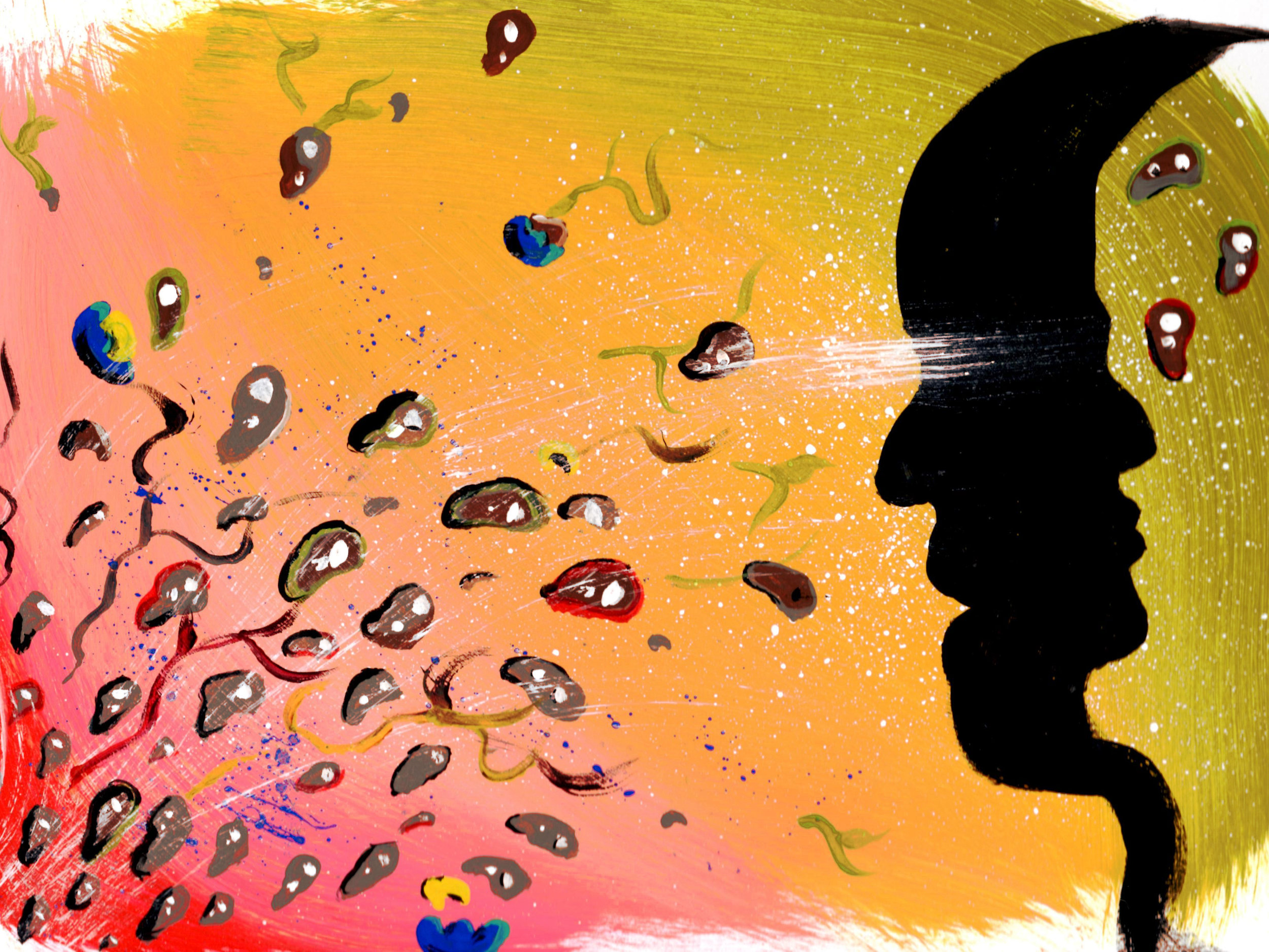
Art credit: Jeff Lauder
Evolution is the process by which an organism becomes more fit for its environment. Often overlooked is how genes evolve over time to make smaller changes to increase the fitness of an organism. The Weinreich lab uses antibiotic resistance genes to study how a gene can evolve in bacteria to give rise to increased resistance. Today we are going to learn about the exciting world of gene evolution and discuss science philosophy with Dr. Weinreich himself.